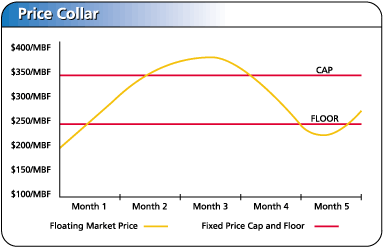 |
Mixing Basic Tools to Create Custom Protection
 By combining the basic instruments - swaps, caps and floors - it is
possible to create customized, cost-efficient price risk management
structures to fit nearly any situation. The number of variations is
limitless; here are a few of the more popular structures.
By combining the basic instruments - swaps, caps and floors - it is
possible to create customized, cost-efficient price risk management
structures to fit nearly any situation. The number of variations is
limitless; here are a few of the more popular structures.
Price Collar
Collars are created by combining a price cap with a floor to reduce
the cost of protection by establishing a range within which prices
will fluctuate. For example, a price cap provides full protection
against rising prices, while affording unlimited benefits if prices
fall. If you are willing to give up the benefit when prices fall
below a specific floor level, the premium paid for the price
protection can be reduced or eliminated altogether. If it is not
necessary to retain unlimited benefit from favorable price moves,
price collars are a cost-saving alternative to a straight cap or floor.
- A producer of lumber or panel products interested in protecting
against a price decline while retaining benefit up to a certain
level would enter into a collar that results in payment from
Enron if prices fall below the floor and, conversely, payment
to Enron should prices exceed the cap.
- A purchaser of lumber or panel products concerned about rising
prices, but needing to maintain the advantage should prices slip
to a certain level, would establish a collar whereby Enron pays
if prices exceed the cap and the company pays if prices fall
below the floor.

Price collars are less expensive to implement than a floor or
cap and can be tailored to meet many of the pricing requirements
of both producers and consumers.
|
Participating Swap
Created by combining a swap with either a price cap or floor, the participating
swap establishes a fixed price while positioning the company to share in some
percentage of beneficial price moves either above or below the swap-fixed price.
The cost of the cap or floor is embedded in the swap-fixed price, so there is
no premium paid for the cap or floor.
Commodity Price Conversion Swap
By combining two swaps on different commodities, the price of one commodity can
be linked to the other. For example, a mill equipped to make only OSB, but that
sells product into a market that competes with plywood, is at risk if plywood
becomes the cheaper sheet. The producer can use a commodity conversion swap
that links OSB prices to plywood prices, putting the company on a more equal
footing with its plywood competitors.
Disclaimer
 |





